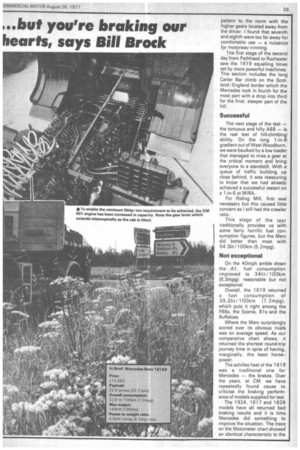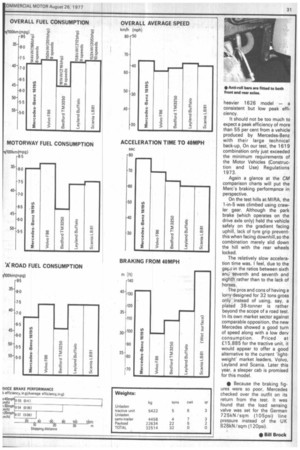Nice one Men
Page 30

Page 31

Page 33

If you've noticed an error in this article please click here to report it so we can fix it.
SEVERAL manufacturers competing in the heavy and of the UK market offer both 'lightweight and 'heavyweight' 32-tonners. Volvo and Leyland are examples of this strategy and, two weeks ago, Mercedes-Benz added the 1619S to its list as a replacement for the long-serving 1418.
Around the CM Scottish test route, the new machine performed well with a high average speed and a good fuel consumption. Other aspects of the Merc's performance were not, however, quite up to the same standard.
The 1619 shares the same 'New Generation' cab as its big brother, the 1626, and the 1617 rigid. The original design concept of the cab was to present a 'non aggressive' external image while sacrificing nothing in the way of interior space.
Modified
Although the 1619 shares the same basic V6 engine specification as the recently introduced Mercedes sixwheeler, it has been modified, considerably, for the UK market. The introduction of a longer throw crankshaft, thereby increasing the swept volume from 9.6 to 10.46 litres (584 to 638cuin), has resulted in a maximum engine output of 144kW (196bhp) at 2,300rpm — just sufficient for the 6bhp/ ton requirement.
Mercedes' own eight-speed range-change box, as used on the 1617 rigid, is employed with the addition of a crawler ratio of 13.36 to 1. The range-change selector is protected by a lock-out device to prevent engagement of the lower gears at a too-high road speed.
On the Ml, I was relieved to find that a cruising speed of 55/60 mph could be maintained for long periods in spite of the relatively low-powered engine and, even on the steeper gradients, it held on very well.
Effortless
The steering was light and effortless, due, in part, to the large steering wheel — fitted to' conform with German regulations which require adequate manual control should the power steering fail — but rutting in the nearside lane caused severe snaking on several occasions.
One criticism that I had of the new Merc concerned the gearbox which has a reversed shift pattern to the norm with the higher gears located away from the driver. I found that seventh and eighth were too far away for comfortable use — a nuisance for motorway running.
Tile first stage of the second day from Path head to Rochester saw the 1619 equalling times set by more powerful machines. This section includes the long Carter Bar climb on the Scotland/England border which the Mercedes took in fourth for the most part with a drop into third for the final, steeper part of the hill.
Successful
The next stage of the test — the tortuous and hilly A68 — is the real test of hilt-climbingi ability. On the long 1-in-9i gradient out of West Woodburn, we were baulked by a low loader that managed to miss a gear at the critical moment and bring everyone to a standstill. With a queue of traffic building up close behind, it was reassuring to know that we had already achieved a successful restart on a 1-in-5 at MIRA.
For Riding Mill, first was necessary but this caused little. concern as I still had the crawler ratio.
This stage of the test traditionally provides us with. some fairly horrific fuel consumption figures, but the Merc did better than most with 54.3Iit/ 100km (5.2mpg).
Not exceptional
On the 40mph amble down the Al, fuel consumption improved to 341it/ 100km (8.3mpg): reasonable but not exceptional.
Overall, the 1619 returned a fuel consumption of 39.2Iit /100km (7.2mpg), which puts it right among the F86s, the Scania, 81s and the Buffaloes.
Where the Merc surprisingly scored over its obvious rivals was on average speed. As our comparative chart shows, it returned the shortest round-trip journey time in spite of having, marginally, the least horsepower.
The achilles heel of the 1619. was a traditional one for Mercedes — the brakes. Over the years, at CM, we have repeatedly found cause to criticise the braking performance of models supplied for test.
The 1924, 1617 and 1626 models have all returned bad braking results and it is time. Mercedes did something to improve the situation. The trace on the Motometer chart showed' an identical characteristic to the heavier 1626 model — a consistent but low peak efficiency.
It should not be too much to expect a peak efficiency of more than 55 per cent from a vehicle produced by Mercedes-Benz with their large technical back-up. On our test, the 1619 combination only just exceeded the minimum requirements of the Motor Vehicles (Construction and Use) Regulations 1973.
Again a glance at the CM comparison charts will put the Merc's braking performance in perspective.
On the test hills at. MIRA, the 1-in-5 was climbed using crawler gear. Although the park brake (which operates on the drive axle only) held the vehicle safely on the gradient facing uphill, lack of tyre grip preventthis when facing downhill so the combination merely slid down the hill with the rear wheels locked.
The relatively slow acceleration time was, I feel, due to the gaps in the ratios between sixth ant; seventh and seventh and eighth rather than to the lack of horses.
The pros and cons of having a lorry designed for 32 tons gross only instead of using, say, a plated 38-tonner is rather beyond the scope of a road test. In its own market sector against comparable opposition, the new Mercedes showed a good turn of speed along with a low dery consumption. Priced at £15,885 for the tractive unit, it would appear to offer a good alternative to the current 'lightweight' market leaders, Volvo, Leyland and Scania. Later this year, a sleeper cab is promised for this model.
• Because the braking figures were so poor, Mercedes checked over the outfit on its return from the test. It was found that the load sensing valve was set for the German 725kN /sqm (105psi) line pressure instead of the UK 828kN /sqm (120psi).
• Bill Brock












































































